This was published 1 year ago
Seeing the wildebeest migration in Masai Mara, Kenya: One of the world's greatest spectacles is amazing and deadly
By James Woodford
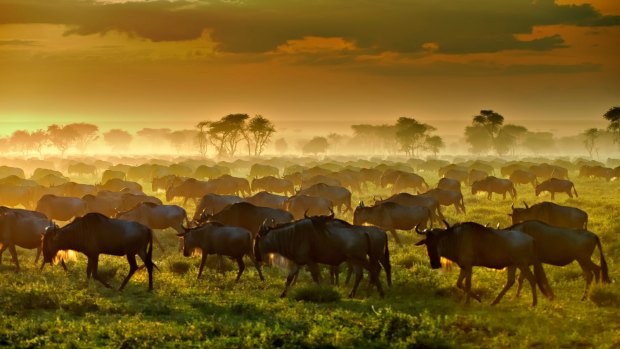
Each year, around a million wildebeests and a quarter of a million zebras make the 700-kilometre circular journey through the Serengeti to the Masai Mara.Credit: Alamy
Amid a haze of smoke and dusk, midway between Nairobi and Lake Victoria, our Cessna C208 Caravan begins its dusk descent into Kenya's Masai Mara, banking as it goes over the darkening ranges that trace the edge of the Great Rift Valley.
As the plane approaches the Mara Serena airstrip, key details within this low-visibility landscape slowly begin to reveal themselves. Beyond the pilot's windscreen as well as the side window I spot zebras, giraffes and wildebeests in small herds grazing on the runway.
Closer to the ground, it's clear the captain is not going to be able to touch down and, instead elects to buzz the grazing masses, sending them galloping out of the plane's path, before the aircraft climbs again, wheels around and finally lands, before taxiing over to the small airstrip shelter.
Once we do manage to safely touch down, beyond the airstrip in every direction and seemingly almost to the horizon, are tens of thousands of wildebeests. Some of them are just metres beyond the four-wheel drive vehicle that has met us while others are mere specks far in the distance across the Mara's vast grassy plains.
This is precisely what I have travelled so far to see — the annual 700-kilometre circular journey of around a million wildebeests and a quarter of a million zebras through the Serengeti to the Masai Mara in search of fresh seasonal pasture. But, as it eventuates, it's merely a preview of the spectacle to come.
DAYS ONE TO TWO: THE GREATEST SHOW ON EARTH
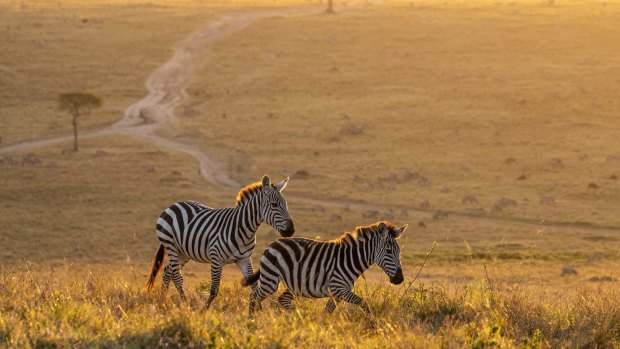
Credit: iStock
I'm in a section of this 50,000 square kilometre Mara-Serengeti ecosystem called the Mara Triangle, which makes up about a third of the 1500 square kilometre Masai Mara National Reserve.
I'm met by Masai guide, Nick Kaleku, who helps load my luggage into a Toyota Landcruiser. Kaleku is working for an Australian, Howard Saunders, professional guide and partner with the venerable Ker & Downey Safaris and founding board member of the Kenya Wildlife Trust.
Saunders first fell in love with Africa as a 17-year-old on a trip with his family and has organised and led bespoke adventures in Kenya and other parts of Africa for more than two decades. I couldn't be in better hands as I begin my African wildlife odyssey.
"This is the Great Migration," says Kaleku, waving his arm at the wildlife spread before us. Even though we need to get to camp I am reluctant to leave this scene as a pink spherical sun nudges the horizon against the backdrop of a huge sky above a landscape dotted with acacia trees and untold herds of wildebeest.
"It's getting dark," he tells me, turning on the ignition of the Landcruiser. "We have to go." Then he smiles at me and says: "The wildebeest will still all be here tomorrow."
A quarter of an hour later we turn onto a rough track and make our way to the Kiboko campsite. Kiboko means hippo in Kiswahili and before long I discover why.
Private camps like this are often the centrepiece of the safaris that Saunders tailors for his clients because they offer a quintessential African wilderness experience.
The camp is in a completely natural setting with no permanent amenities, high on a 10-metre bank, beside a bend in the Mara River amid thick, low forest. Everything including water is trucked in and set up to cater for the individual safari groups organised by Saunders.
Almost a dozen staff wait to greet Kaleku and I as we climb out of the Landcruiser. A quarter of an hour later I am in a luxurious tent with a queen-sized bed, bathroom, toilet and verandah area, soaking in an unexpectedly-steaming hot shower.
The pandemic was something of an ordeal for the people of a tourism-dependent Masai Mara as well as for tourist operators themselves with companies such as Saunders' organising fundraising events to help the community get through it.
Fortunately, 2022 has seen tourism numbers return, however, there is increasing pressure for better management and stricter limits on tourist numbers to protect the environment and stop tourists from interfering with the migration.
Half an hour later I'm sitting across from Saunders' camp manager Michael Njoroge. We are served a three-course meal at a table under a huge open dining tent that could have been set for a Michelin Star restaurant only there is no ambient music.
The aural accompaniment to our meal consists of the loud gurgles, growls, belches and bellows of the wildlife around us. There's even the sound of splashes emerging from a huge hippo group in the Mara River below our camp.
The staff lead me to the edge of the small cliff beside the river and shine their torches down into the water. It seems everywhere below us are hippos, widely regarded as the most dangerous African animal. Not only is the river thick with them, the torches manage to reveal the presence of Nile crocodiles.
At 6am I hear my name being called from outside the tent. Steaming local Kenya-style Keinyeji tea, like a spicy masala chai, is waiting for me in a thermos outside on my verandah. By 6.30am, I'm inside the Landcruiser again with Kaleku.
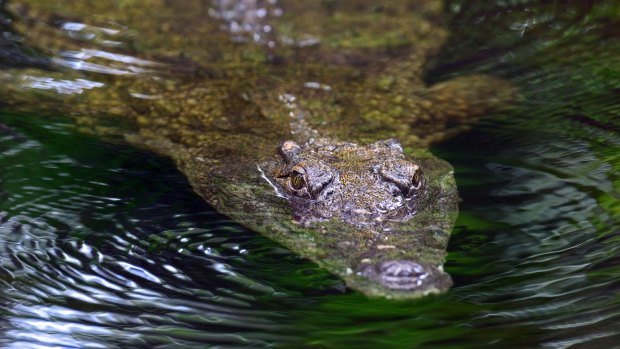
Credit: iStock
Not even 100 metres beyond the edge of the camp we startle a hippo crossing the track and a few minutes later, just after sunrise, find a group of lions feasting on a wildebeest that had been killed the evening before.
Seeing the pride of lions, listening to the enormous, projecting bass of their growls and roars and the humid, pungent smell of composting grass that fills the air when the beast's intestines are torn open in front of us, I realise the landscape might superficially look similar to parts of Australia but the rules here are completely different.
Far away, Kaleku points to an almost imperceptible cloud of dust rising from the river. "It's a wildebeest crossing," he says, signalling for me to climb down from my viewing position, standing with my upper body through the roof of the vehicle.
As we approach the dust cloud, I can make out huge tributaries of wildebeest on the other side of the Mara River converging at this crossing point, moving like the braided ribbons of a waterway.
The sight is biblical — tens of thousands of fleeing wildebeest refugees moving at a rapid pace. The combined noise of so many zebras and wildebeests crossing the river is like a deafening, honking waterfall combined with distant thunder.
Kaleku positions the Landcruiser on the lip of the river bank where we have a vantage of the cascade of zebra and wildebeest down into the river as well as their paths up the other side after they emerge from the waterway.
Crocodiles are hiding underwater, waiting to grab prey, and lions man the exit and entry points. Up and down the river bed we can also see spotted hyenas patrolling for stragglers.
There is something primal, bloodthirsty, terrifying and reminiscent of a Colosseum gladiatorial battle in the way the animals cross the river, knowing that at any step they could be dragged underwater by a five-metre reptile or set upon by a lion as they emerge or descend the river's banks.
The wildebeests and zebras hit the water thirsty, torn between the instinct to get to the other side and to quickly quench themselves.
After 10 minutes the momentum and pressure on the wildebeest herd still on the other side mysteriously begins to ease until a few final individuals make the race across and then it is all over.
That morning thousands of wildebeest and zebras succeed in their effort to make it through the Mara River unscathed.
No one can predict when or where on the Mara River the next crossing will happen, that day or in the coming weeks, until all the wildebeest in the herd have made it over to our side. And so, witnessing a crossing will elude many Great Migration safari pilgrims.
The fact that Kaleku managed to show me one on my first morning in the Mara was a source of amazement to those I tell about the experience.
DAYS TWO AND THREE: AMONG THE BIG FIVE
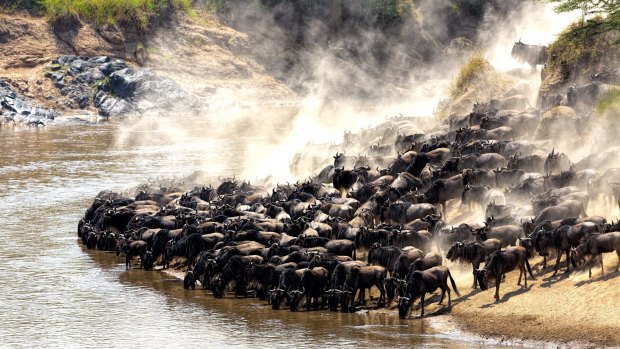
Credit: iStock
"There's nowhere else on the planet where you have this great abundance of large mammal life, which is so visible," says Saunders the next day. He's joined us in the Landcruiser as we pass among the wildebeest and zebra migrants. "The sheer number of wildebeests is astonishing but also amazing is the predator-prey interactions.
"People come for the energy and excitement. You can see and feel the anxiety of the animals there. You are so close to that massive force of nature. On a huge scale, extremes of life and death are playing out in front of you."
Over the next few days we head out into the open fields of the park in search of the other wildlife massing at this extraordinarily bountiful time of year.
The Masai Mara is home to representatives of all of the "Big Five" — leopards, lions, Cape buffalo, elephants, and black rhinoceros. Saunders does a lot of work supporting researchers and philanthropists in order to get greater understanding and protection for the region.
For me, being able to sit down over a meal with veteran hyena biologists who pass through camp or spend several evenings with young doctoral students is a highlight of my stay.
In the middle of our days in the Mara, because of the camp's location on the banks of the river, it is a perfect viewing platform for sitting quietly and safely, watching not only the resident hippos and crocodiles but also the parade of wild creatures that come down to drink or hunt.
One afternoon Saunders and I observe an elephant mother with her calf drinking. A crocodile gets too close as the enormous mother casually flicks the crocodile away with her trunk. Mongoose families creep past my tent and then each dawn and dusk I head out again.
We can never predict what kind of behaviour we will observe, where the wildebeest will next cross, what meal the local prides of lions will have brought down or what combination of landscape, light, wildlife, clouds and trees will combine to perform infinite permutations of dawns and dusks that leave us awestruck.
Kaleku and my last safari together takes us past a group of armed rangers guarding a group of black rhinos day and night to protect them from poachers and interference from tourists. He stops and speaks to the park rangers who point to the dense patch of woodland where the rhinos are sheltering.
We wait for as long as we can but even though the rhinos are just a hundred metres away we are unable to see them.
DAYS THREE TO FIVE: WALLOWING WITH KOFI AND ELIZABETH
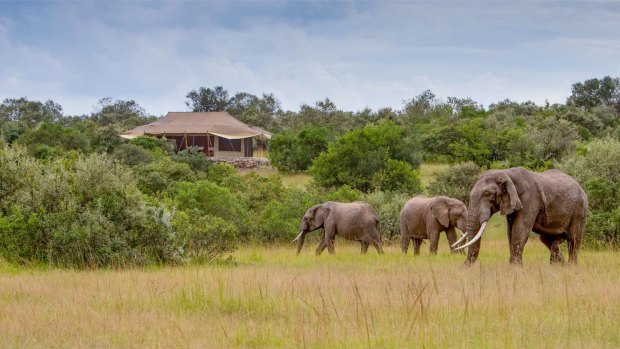
On my third morning, Kaleku hands me over to another Masai guide who works with Saunders, Moses Nampaso. He and I plan to continue the daily routine of dawn and dusk safaris but this time outside the Mara Triangle and the national reserve.
We drive north and travel within the privately-owned conservancies that make up the Greater Mara, such as Enonkishu (where Saunders is a conservancy board member), and Ol Choro.
Because Nampasos is local to the northern Mara area, Saunders has built an itinerary that will give me an opportunity to see the interface between tourism, wildlife and Masai culture with a person who has lived in the Mara his entire life
Although Nampaso often works with Saunders, he also has his own private safari camp and business, Mattikoko Safari Camp. He is passionate about Masai culture and the Mara.
"This is my home," he tells me. "We live with wildlife and that strengthens our bond with them, we love wildlife the way we love our cows, sheep and goats."
He offers to show me Masai cows, sheep and goats. Late one morning Nampaso and I arrive at the township of Aitong, where he attended school, walking seven kilometres each way from his village in the Mara.
The day we arrive is the weekly cattle market and hundreds of herdsmen, many armed with swords, clubs and sticks, are crowded into an enclosure that is maybe a couple of hectares in size. Each herdsman has his cattle bunched together in tight circles, kept under control with sticks.
Nampaso seems to know everyone — he has no less than 25 siblings — and, every few metres, he stops and engages in animated conversation with someone.
Most of the men are wearing the distinctive Masai tartan throws over their shoulders making the cattle market feel more like an explosion of colour at a music festival than a place to trade animals.
Some of the cattle are unruly and difficult to keep in their small herd — occasionally a ruckus breaks out as one of the animals breaks away, leading to lots of shouting and stick waving.
At the sight of one particularly flighty steer, kicking and attempting to escape, and looking as though it could charge at us, Nampaso grabs my arm and says: "We need to get out of here. Now."
After missing out on spotting a rhino a few days earlier, I am determined to accept his offer to take me to the Rhino Sanctuary within the Ol Choro Conservancy. There are two white rhinos at Ol Choro, though, neither are Kenyan, where black rhinos are endemic species. Both are under very heavy armed guard.
"One is called 'Kofi Annan' and the other 'Queen Elizabeth'," he says. "A couple of times a week the rangers even walk with Kofi and Elizabeth down to a waterhole so they can wallow. They move them with sticks like cows."
On a cold grey morning, as my time on safari is drawing to a close, Nampaso and I drive to the Rhino Sanctuary and I meet with rangers who walk with me through thick scrub on the side of the mountain at Ol Choro.
The ranger explains that Queen Elizabeth is not very friendly and while we can see her I am not to approach. Kofi, however, is relaxed and calm and I walk right up to within an arm's-length of his side.
After nearly a week of watching vast megafauna from a distance, stretching out my open hand to gently and slowly touch down on Kofi's parched and wrinkled rump, makes me feel as though, just as I was about to leave this extraordinary and precious part of planet Earth, I have actually only just arrived.
The writer travelled at his own expense.
THE DETAILS
SAFARI
There are a range of safari options from the bespoke, private guided model, with deluxe Hemingway style tented camps; to combining a selection of boutique safari lodges throughout the diverse regions of East Africa. Privately guided safaris for 2023 with Howard Saunders start from an all-inclusive $US1500 a person a night. All safaris are tailor made and typically range from seven to 12 days. See www.howardsaunders.com
BOOK
The Sydney-based Classic Safari Company. Phone 1300 130 218, see visit classicsafaricompany.com.au
FLY
Emirates flies daily from Sydney and Melbourne to Dubai with daily connections to Nairobi, the Kenyan capital. See emirates.com
KNOW
While caution is required in Kenyan cities such as Nairobi, travel elsewhere in the country is generally safe and all tours handled by professionals who know the landscape intimately. COVID-19 tests are not required for entry to Kenya. See smartraveller.com.au
MORE
FIVE OTHER SPECTACULAR WILDLIFE MIGRATIONS
Humpback whales in Antarctica and Australia
Fresh from feasting on krill in the Antarctic, humpback whales, one of the most active whales in terms of behaviour, migrate up the east coast of Australia to subtropical waters between April and November where they calf before returning south. See antarctica.gov.au
Whale sharks in Western Australia
The world's biggest fish gather in the waters of Ningaloo Reef off north-west Western Australia from April to July and, according to the Australian Institute of Marine Science, "can migrate thousands of kilometres to other countries though much remains mysterious." See westernaustralia.com
Caribou in Alaska, US
The Western Arctic Herd is one of the largest caribou herds in the world with an estimated population of 259,000, they range over a territory of about 157,000 square miles in Northwest Alaska. Twice a year, caribou journey between their summer and winter range. See nps.gov
Butterflies in North America
Flying as far as 4000 kilometres from the US and Canada where they breed, all the way down to the forests in central Mexico where they hibernate, the monarch butterfly's migratory pattern is the most highly evolved of any known species of their kind." See wwf.org.au
Asian Flyways, Arctic, Australia and NZ
Every year, as autumn falls in the northern hemisphere, millions of birds undertake an arduous journey of over 13,000 km, from breeding grounds as far north as the Arctic Circle to overwintering grounds as far south as Australia and New Zealand, and then return the next year." See wwf.org.au
Sign up for the Traveller Deals newsletter
Get exclusive travel deals delivered straight to your inbox. Sign up now.